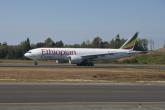The Boeing 747-8 freighter, the next-generation cargo aircraft coveted
for years by airfreight carriers such as Cargolux and Atlas Air, finally
entered service in October after multiple program delays.
The aircraft
will play a critical role in future widebody cargo fleets, but certainly
is not the only option for lessors and carriers seeking freighters to
fly heavy payloads long distances.
Boeing and Israel Aerospace Industries’ Bedek Aviation Group (IAI
Bedek) continue to press the case for converted widebody freighters,
asserting that new-builds will not be able to satisfy demand.
“The purchase price of converted large freighters is very attractive,
and conversions will continue to play an important supporting role” in
populating the global all-cargo fleet, Boeing stated in its most recent
forecast. The manufacturer projects demand for 1,000 new 80-ton-plus
freighters over the next 20 years; some 31% will be conversions.
“The entire market can’t just be served by new aircraft,” Boeing VP-freighter conversions Dan da Silva told ATW.
“When you look at the larger 747 conversion market, there are still
airlines in the world utilizing the old 747-200 freighters. With the
price of fuel where it is and the fact that the 747-200 requires a
three-man crew, you can see that those airlines that are still operating
747-200s are very likely to go to a newer airplane going forward.
But
if they’re still operating 747-200s, it’s very unlikely they are going
to jump into the 747-8. So we look at all of those airlines as very good
candidates for 747-400 converted freighters.” Potential examples would
include Kalitta Air and Evergreen International Airlines.
IAI Bedek VP and GM-market and business development Jack Gaber added,
“As a large freighter, the 747 is unique in its niche. It’s absolutely
unique . . . I think in the next few years we will see many 747-400
conversions.”
Boeing and IAI Bedek have competing 747-400 conversion programs, though
Boeing contracts out the touch work to Taikoo Aircraft Engineering
Corp.
With worldwide cargo traffic’s fast rebound in 2010 from a severe dip
in 2008-2009, orders rolled in (relatively speaking) for 747-400
conversions. But as the cargo market slumped in the second half of this
year, lessors and airlines again pulled back from making decisions to
convert 747-400 passenger aircraft to freighters.
Gaber said IAI Bedek will deliver over 20 conversions this year with
747-400s leading the way.
“The most we have ever delivered. Definitely
it has been a very good year, or two years. Next year, we are busy
earlier but as we go forward . . . we sense slots are not closing as
quickly as they did a year ago. It doesn’t mean it’s not happening, just
that it could take longer. I don’t think we are going to see a long
slowdown,” Gaber said.
Da Silva was similarly cautious. “The mood in the air cargo market
right now is not exactly optimistic. A lot of cargo carriers are
concerned about the economic situation and the prospects for economic
growth. We are still optimistic about a 2011 that will be flat. You had
growth in the first half of the year and mild, negative cargo trends in
the July through September timeframe,” he said.
IATA said the 2011 third quarter saw “cargo markets deteriorate
significantly . . . Airfreight markets started to shrink in the middle
of 2011, after over a year of stagnation. Weakness was experienced
across all major markets, particularly in Asia.” Global FTKs were down
3.8% year-over-year for the month of August, IATA reported.
Da Silva said Boeing remains cautiously optimistic about air cargo
demand in 2012, and therefore demand for converted freighters: “Unless
we head into some sort of shock, we should resume growth in 2012.
Inventory levels are very low right now. Manufacturers have been very
reluctant to bring back pre-crisis [2008] levels of inventory. Inventory
replenishment is one of those areas where we think there’s potential
for quick cargo growth in a recovery . . . Boeing is now forecasting
7.1% air cargo [traffic] growth in 2012. We have pushed some of the
growth that we expected this year into next year.”
Gaber commented that everyone is taking a step back to see where the
world economy is going and that very few lessors or airlines were
willing to do a conversion on a speculative basis. But he added that if
you’re looking at 2013 capacity, then the time to make a decision on a
conversion is now to reserve a slot in 2012.
“It’s not easy to make a
decision that far out with so much money involved, but those who made
[the decision to place conversions orders in] 2009 . . . had the
aircraft when they needed them. When the market came back, they had the
aircraft,” he said.
747-8F EIS
The 747-8F may be the most modern and efficient large freighter
available, but is not necessarily an economical choice for many
lessors/carriers. That is especially so given the aircraft’s delayed
entry into service (EIS); first delivery this fall came two years late.
Adding further to Boeing’s troubles, launch customer Cargolux declined
delivery in September, citing performance shortfalls. The
Luxembourg-based company, Europe’s largest all-cargo airline, finally
did accept its aircraft in October.
But Atlas Air Worldwide Holdings, the parent of Atlas Air and Polar Air
Cargo that had long been eager to take delivery of its 747-8Fs to place
them into ACMI services, canceled three of the 12 it had on order,
lending credence to the notion that the aircraft—or, at least, the
early-build units—fall short of promised performance metrics.
Even putting the 747-8F program’s controversies aside, it is not
comparable to the 747-400 converted freighter in terms of the upfront
investment required.
Da Silva said there were two very different cargo markets for the 747.
“The 747[-400] converted freighter does not compete directly with the
747-8. You clearly see a division of customers and operations that can
justify an -8F and ones that cannot, whether it’s because their
utilization is not high enough, their market is not high-yield enough or
they don’t have financial wherewithal to invest in a new airplane. We
see those two products as very complementary and we don’t see them
competing directly,” he said.
Gaber agreed, noting that a 747-8F costs “$200 million or so . . . You
can have a [used passenger] 747-400 aircraft in today’s prices at $15
million. So, for between $40-$50 million, you can get an aircraft
converted. I mean the whole conversion—the freighter, the conversion,
the whole thing . . . for $40-$45 million. You can have five aircraft
for the price of one [-8F]. You can have a fleet. For any practical
purpose, the -400 will provide you the weight and volume and range that
you need. Of course, the operation for a -8F will be a little more
efficient.”
Da Silva put the difference at closer to $150 million vs. $50 million,
but the point is the same. “What does happen is that as the premier
carriers take delivery of the -8F, shares of the cargo market are taken
up . . . So that could indirectly affect the market out there for
conversions but not significantly long-term,” he said.
It is true, however, that used 747-400s, particularly in the
15-20-year-old age range that make the aircraft ideal for conversion to
freighters, can be acquired for as low as $15 million with prices
trending down. (A used 747-400 was valued as high as $40 million in
early 2008.)
The 747-8F is 250 ft., 2 in. (76.3 m.) long, making it 18 ft., 4 in. (5.6 m.) longer than the 747-400F.
777-200ER Conversion?
Gaber said the big competitor to the 747-400 converted freighter will
be a 777 converted freighter, but that program is still at the
speculative phase.
“The 777 is not coming anytime soon. Probably somewhere between 2016
and 2018. And even when the 777 shows up, only the later version of the
777 will carry the weight that the 747 can carry,” he said.
Da Silva agreed that the story hasn’t changed much regarding Boeing
launching a 777-200 converted freighter program. “We continue to work on
product development. We’ve made some positive progress in the last year
in reviewing the business case. We are more strongly focused on the
-200ER than we are on the -200 . . . We think less and less that the
market is attractive enough to warrant an investment. So we’re focusing
more and more on the -200ER,” he said.
“We continue to talk to customers on a regular basis . . . The
consensus is the -200ER residual value has to be in the low-$30 million
range to become attractive for conversions. And right now that airplane
is still clearly in the mid-$40 million range in value. That’s an
expensive airplane to convert.”
Gaber said a 747-400 converted freighter would still trump a 777-200ER
conversion. “You have to go to the 777-300 to carry the same amount of
weight or get close. That’s why I say the 747 is very unique.”
Still, Boeing and IAI understand that a 747-400 passenger-to-freighter
program is a long-term endeavor. “We’re talking about 15 airplanes a
year going forward over the next 20 years. We don’t see that as a low
demand,” Da Silva said.
Boeing has delivered a total of 47 747-400 converted freighters,
including three over the past year. The peak year for total 747-400
conversions (Boeing and IAI Bedek combined) was 2006 with 26 deliveries;
this year’s total may push close to that figure but likely will fall
short. Only 13 were delivered for all of 2009 and 2010 combined.
767-300 Stalled
For carriers looking for a step down in widebody size and range from
the 747-400, Boeing and IAI Bedek also compete on 767-300 conversions,
though a paucity of available feedstock has temporarily ground both
companies’ programs to a halt. (Boeing contracts out the touch work to
ST Aviation Services Co.)
“There’s not a lot of aircraft available,” Gaber said. “A lot of
[767-300s] are operating [as passenger aircraft] beyond expectations
because of the delay in the 787 program and other factors.” Prices for
used 767-300s “are still a little high,” he said.
“I would characterize the 767 as more than slow. It’s almost
unavailable,” Da Silva said. He pointed out that there were 658
767-300ERs in existence as of Oct. 31. But almost none are available for
sale. “There are less than six airplanes being traded this year,” he
said.
Gaber said he knew of companies that would buy 767-300s for conversions
if they find a sister-ship fleet of the type. “It’s not about buying
one aircraft, but five or 10 sister-ships to go in for conversion.”
Nevertheless, Gaber feels the 767-300 conversion has a future because it is relatively very efficient.
Da Silva agrees. “We still see the 767 as the midsize freighter that
will be perfect for express freight transportation in domestic markets
in China and Russia and Brazil. As these markets develop, as consumers
in these markets start buying more from on online retail, more and more
demand for express air cargo will emerge,” he said.
Demand in China and on intra-Asia routes will “very soon” lead to
demand for 767-300 conversions, he predicted: “In less than 18 months,
we’ll quickly see some of these 757 [freighter] operators quickly
outgrowing those aircraft in terms of need and requiring 767-type
airplanes.”














